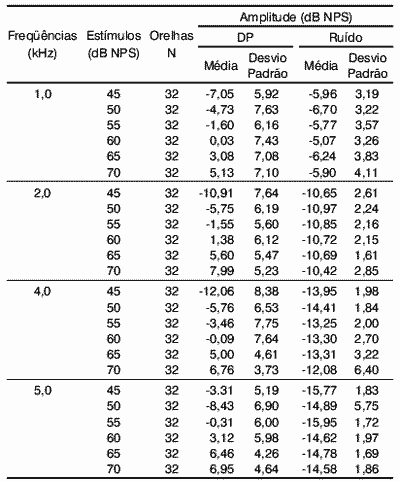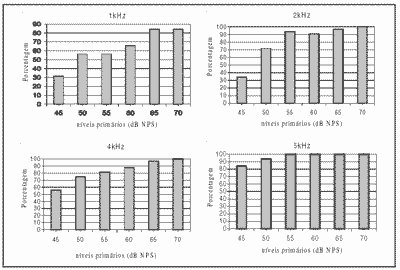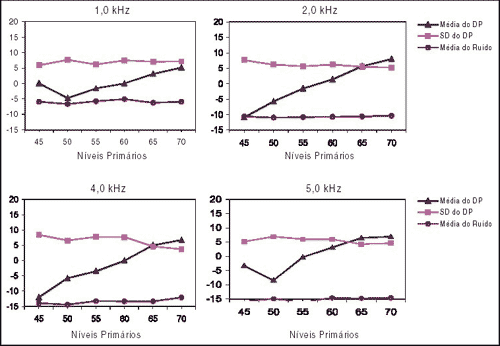

Year: 2002 Vol. 68 Ed. 1 - (4º)
Artigo Original
Pages: 21 to 26
Study of the dp growth rate answers pattern of the otoacustic emission distortion product in normal hearing people
Author(s):
Juliana B. Tiradentes 1,
Carmen Z. V. Coube 2,
Orozimbo A. Costa Filho 3
Keywords: hearing, otoacoustic emissions, growth rates.
Abstract:
Study design: clinical prospective randomized. Material and method: at the present work it was registered answers of the growth rates at frequencies of 1,000, 2,000, 4,000 and 5,000 Hertz with sound stimulus of 45 to 70 dB SPL in beats of 5 dB per point, being the F2/F1 rate equals to 1.22. Sixteen normally hearing "perfect" people between 18 to 25 years old were evaluated. The equipment used for the test was the ILO 92 OTODYNAMIC Inc. The answers were considered present when 3 dB above the back noise was registered. Result: There was no statistics significant difference in relation to age, sex and right ear and left ear. The DPOAE occurrence was of 100% at the frequencies of 2,000, 4,000 and 5,000 Hertz and of 84.37% at the 1,000-Hertz frequency when the cochlea was stimulated at 70 dB SPL. Conclusion: The growth rates showed a linear aspect inclination without plateau, although the back noise kept itself constant, showing a slight increase from the 55-dB SPL stimulus.
![]()
1 Specialist in Clinical Audiology, University of São Paulo (USP), Bauru- SP.
2 Professor, Course of Speech and Hearing Therapy, Dental School - Bauru (FOB) USP, Ph.D. in Audiology Sciences, Hospital de Reabilitação de Anomalias Craniofaciais (HRAC), USP and Researcher of Centro de Pesquisas Audiológicas (CPA), USP, Bauru-SP.
3 Full Professor in Otorhinolaryngology, Course of Speech and Hearing Therapy, FOB -USP, Otorhinolaryngologist and Coordinator of CPA- HRAC-USP- Bauru/SP.
Address correspondence to: Centro de Pesquisas Audiológicas do HRAC-USP Rua Sílvio Marchione, 3-20 - 17043-900 - Bauru - SP. Tel: (55 14) 235 8433. Fax: (55 14) 234 2280 - E-mail:czvcoube@fob.usp.br
Study conducted at Centro de Pesquisas Audiológicas (CPA) , Hospital de Reabilitação de Anomalias Craniofaciais (HRAC), University of São Paulo - Bauru - SP, Monograph submitted for the Specialization in Clinical Audiology.
Article submitted on October 10, 2001. Article accepted on November 20, 2001.
INTRODUCTION
Otoacoustic emissions may be defined as sound energy released from the cochlea and transmitted backwards through the middle ear until it reaches the external acoustic canal, where they are recorded by a probe and registered in the computer7.
The test of distortion product otoacoustic emissions (DPOAE) consists of a method that records responses of the outer hair cells (OHC) present in Corti's organ, and when normal, they operate in favor of the normal physiological mechanisms of the inner ear4, 12.
These sounds are of low amplitude, so they have to be amplified in order to be recorded and analyzed. The tympanic-ossicle set should be operating normally so that the sounds coming from the cochlea may be captured by the external acoustic canal. Thus, tympanometry is considered a pre-requirement for the test, since any alterations may reduce or even exclude the occurrence of otoacoustic emissions.
DPOAE are a result of the non-linear interaction of two simultaneous pure tones, applied into the cochlea6. The two tones are presented by two different frequencies (F1 and F2), which are called primary frequencies. In humans, the amplest DPOAE is detected at the frequency equivalent to 2F1 - F2, where F1 < F2.
Distortion products are, technologically speaking, one of the easiest types of otoacoustic emissions to be measured, since they are relatively free from artifacts and do not require posterior processing 5, 10.
In clinical practice, distortion product may be obtained in 3 different ways:
1. Graph amplitude spectrum: analysis of responses to the acoustic stimuli at a given frequency and intensity.
2. DP gram: amplitude of emissions is obtained in different frequencies at a pre-determined sound intensity.
3. DP growth rate: it analyzes the responses to a specific frequency and in different intensities, trying to find the response threshold to the presented stimulus.
A number of researchers have studied the importance and the clinical use of growth rate of DPOAE.
DP growth rate is a common form of DPOAE, which is obtained from a specific frequency in which the emission amplitude is recorded as a function of systematic growth at the level of primary tones. Specific geometrical mean of studied frequencies is equivalent to audiometric frequencies of 500, 1000, 2000, 3000, 4000, 6000 e 8000 Hertz.
DP growth rate may provide information about thresholds and growth rates of distortion product but for a limited number of frequencies and within a specific period of time. In the test, we still do not know which parameter provides more information: thresholds, maximum amplitude or saturation point (if the function really saturates)5.
Lonsbury-Martin et al.9 studied the basic properties of distortion product otoacoustic emissions in subjects with normal hearing. They collected data from 44 ears of 22 young adults aged 21 to 30 years. Two pure tone, same level stimuli, F1 and F2, were presented simultaneously in the primary tone frequency, which generated 2f1-f2 DPOAE between 0.750 and 5.750 Hertz. DP growth rates were generated with primary stimuli of 25 to 85 SPL (Sound Pressure Level) in 5db steps, in 11 frequencies located in intervals of ¼ octaves. Analysis showed that distortion product otoacoustic emissions were presented in the 44 tested ears. DP growth rates indicated that DPOAE responses in humans presented a dynamic range of approximately 40 dB. The thresholds of distortion product were also correlated with the two ears of each subject, but at a lesser extension than amplitude.
Many authors have chosen to study the occurrence and effectiveness of transient evoked otoacoustic emissions, which present important clinical application. Studies concerning analysis of distortion product otoacoustic emissions are, however, more updated and have gained growing scientific interest11.Table 1. Occurrence of distortion product growth rates (32 ears).Figure 1. Occurrence of distortion product in growth rates (32 ears).Figure 2. Growth rate of distortion product and background noise.
Avan et al.1, in 1992, conducted a study to define the most important parameters for clinical application of distortion product otoacoustic emissions. They tested two groups of subjects. The first one comprised 25 normal hearing subjects, whereas the second one had 50 subjects with endocochlear perceptual deafness. Ages ranged from 20 to 70 years. DP growth rates were performed with intensities that varied from 70 to 40 dBSPL in 10-dB steps. The authors reported that when the cochlea was stimulated by two primary frequencies at 70 dBSPL, the incidence of DPOAE in the ears with normal hearing was 100%, whereas at 40dBSPL, the incidence was 32 to 77%.
Kimberley et al.8, in 1994, recorded growth rates of distortion product otoacoustic emissions, pure tone thresholds and demographic data of 229 ears with normal hearing and with hearing impairment. They maintained a constant proportion F2/F1 of 1.22. Growth rates of DPOAE were evaluated for F2 in 1025, 1464, 2050, 2880, 4052 and 5712 Hertz. When amplitude of DPOAE was measured with moderate level F2 (50 dBSPL) and a frequency at the level of pure tone, they presented the best prognosis among the 45 assessed variables of DPOAE and demographic data. The authors noticed that the level of DPOAE was correlated with age and they concluded that age should always be included among the discriminating functions. The results indicated that DPOAE assessments may safely classify pure tone thresholds as normal or impaired under varied cochlear auditory conditions.
Coube3 recorded growth rates of DPOAE in frequencies 1000, 1500 and 3000 Hertz at 45 to 70dB SPL stimuli. All tested subjects presented DPOAE and occurrence decreased as a result of intensity decrease. The threshold of emissions varied, on average, 46 to 50 dB SPL, depending on the tested frequency.
The purpose of the present paper was to study growth rate of DPOAE in normal subjects, in frequencies 1000, 2000, 4000 and 5000Hz concerning the aspects occurrence and characteristics of amplitude in order to support routine clinical applications.
MATERIAL AND METHOD
Sixteen subjects were studied (10 female and 6 male subjects), ages ranging from 18 to 26 years.
As selection criteria, we considered absence of otological pathology, normal otoscopic examination, and pure tone and tympanometry within normal range.
Subjects were tested on both sides (32 ears) using audiometer Midimate 622, Madsen Electronics and impedanciometer Immittance System ZO-2020 (Madsen MP200). Next, we recorded distortion product otoacoustic emissions using the device ILO 92 DP and Transient OAE Analysis (Otodynamics Ltd.), developed by David Kemp, researcher of the Institute of Laryngology and Otology (ILO), from the University of London. The test was performed in a soundproof booth.
For dp growth rates, we analyzed frequencies of 1000, 2000, 4000 and 5000Hz. F2/F2 proportion used was 1.22, at 5-dB steps. The stimuli varied from 45 to 70 dB SPL.
In order to consider presence or absence of distortion product otoacoustic emissions, we used the criterion of responses 3 dB above the second standard deviation of back ground noise, according to the control made by the equipment.
We were careful about suitability of probe to the acoustic ear canal, preventing artifacts or noise contamination.
RESULTS
Data collected by the present study showed the presence of measurable DPOAE in 100% of the 32 tested ears.
Table 1 and Figure 1 show the occurrence of otoacoustic emissions, following the criterion of responses 3 dB above the second standard deviation of background noise. When the cochlea was stimulated by two primary frequencies of 70 dB SPL, the occurrence of DPOAE was 84.37% in the frequency of 1000 Hz and 100% in the frequency of 2000, 4000 and 5000Hz. However, when the stimulus level was 45 dBSPL, the occurrence of DPOAE varied from 31.25% to 84.37%, depending on the tested frequency. In the frequency of 5 kHz, there was 100% occurrence as from the 55-dB SPL stimulus.
DPOAE thresholds of dp growth rate are presented in Table 2 for both genders and ears. We noticed that the minimum intensity level required to reach a response was 45 dB SPL in frequencies of 4000 and 5000Hz and 50 dB SPL for frequencies 1000 and 2000Hz. For all tested frequencies, we noticed a maximum emission level of 70 dB SPL.
Mean amplitudes and standard deviations of DPOAE and background noise, observed in dp growth rates, with different stimuli ranging from 45 to 70 dB SPL in frequencies 1000, 2000, 4000 and 5000 HZ, are shown in Table 3.
The inclination of dp growth rate was more marked for the frequency of 2000Hz, because mean amplitudes of DPOAE were lower in frequencies 1000, 40000 and 5000 Hz, especially when the stimulus was 70 dB SPL (Table 3).
Figure 2 shows that growth rate for DPOAE presented a linear inclination, with no plateau, in frequencies 2000 and 4000 Hz, which increased as from the intensity of 65 dB SPL. In frequencies of 1000 and 5000Hz, the inclination of dp growth rates increased as from the frequency of 50 dB SPL.
Background noise varied, on average, in the frequency of 1000 Hertz from -6.07 to -5.07 dB SPL; in the frequency of 2000 Hertz from -10.97 to -10.42 dB SPL; in the frequency of 4000 Hertz from -14.41 to -12.08 dB SPL, and in the frequency of 5000 Hertz from -15.95 to -14.58 dB SPL.
DISCUSSION
Identification of otoacoustic emissions tends now to be included in the routine audiological battery of tests, since it is a quick, non-invasive and objective procedure.
Cochlear response evoked by 2 pure tones of 2 different frequencies, as described by Kemp6, has caught the attention of audiologists. Distortion product otoacoustic emissions present frequency specificity and a wide dynamic range, enabling complete assessment of the cochlear function.
DPOAE are present in subjects with normal hearing, so hair cells of Corti's organ, if healthy, generate distortion product4.
A series of studies are being conducted with emissions, addressing all different aspects in experimental conditions to observe distortion product in human clinical application, such as reported by Kemp et al.7.
In the sample used by the present study in normal hearing subjects, DPOAE responses were present in all tested ears (n=32) that presented pure tone thresholds lower than 20 dB HL, a fact that has already been demonstrated and confirmed by many research studies, such as the one performed by Robles et al.12, with animal model.
In the sample, the occurrence of DPOAE became more frequent as a result of increase in stimulus intensity. Thus, for the frequency 1000 Hertz, the occurrence was 31.25% for 45-dB SPL stimulus and it increased up to 84. 34% in 70 dB SPL. For the frequency of 2000 Hertz, there was 34.37% of DPOAE at the stimulus of 45 dB SPL and the occurrence gradually increased as a result of stimulus increase, up to 100% in 70 dB SPL. For the frequency of 4000 Hertz, at 45-dB SPL stimulus, the occurrence was 56.25%, but with 70 dB SPL stimulus, it became 100%. For the frequency of 5000 Hertz, with 45 dB SPL stimulus, the occurrence was 84.37%, reaching 93.75% with 50 dB SPL stimulus and 100% when the levels of the primary tone were 55, 60, 65 and 70 dB SPL (Table 1 and Figure 1). These findings are similar to those reported by Avan et al.1 and Coube3. The greater occurrence of otoacoustic emissions in frequencies higher than 1000 Hertz was reported by the study of Bonfilis et al.2, in which the author justified the findings by the fact that there was more contamination of background noise in low frequencies.
As to thresholds of distortion product (Table 2), the minimum was found at 50 dB SPL for frequencies of 1000 and 2000Hz and 45 dB SPL for frequencies of 4000 and 5000Hz. The maximum threshold was 70 dB SPL for all tested frequencies.
The analysis of dp growth rate revealed that functions were linear and did not show plateau, similarly to the findings reported by Roede et al.13 and Coube3.
The results of DPOAE found by other studies9 did not agree among themselves nor with the ones collected for the present study. It confirms the fact that unless we standardize the methodology, we will never be able to establish universally applicable values.
CONCLUSIONS
The results found by the present study enabled the conclusion that in normal hearing subjects:
· the occurrence of DPOAE was 100% in frequencies of 2000, 4000 and 5000 Hertz at 70dBSPL stimuli and it ranged from 31.25 to 84.37% in frequencies of 1000, 2000, 4000 and 5000 Hertz at 45dBSPL stimuli;
· dp growth rate were linear, without plateau, and the inclination was more marked in frequencies 2000 and 4000Hz as from the intensity of 65 dB SPL and in frequencies 1000 and 5000 Hz, as from 50 dB SPL;
· DPOAE thresholds were, on average, between 45 and 70 dB SPL, depending on the tested frequency;
· amplitude range of DPOAE was on average 52 to 39 dBSPL in frequency 1000 Hertz; 55 to 37 dB SPL in frequency 2000 Hertz; 57 to 38 dB SPL in frequency 4000 Hertz and 53 to 38 dB SPL in frequency 5000 Hertz, below the initial level of the primary tones (45 dB SPL).
REFERENCES
1. Avan, P.; Bonfils, P.; Paoli, C.; Gallas, D.; Cymes, M.; Nores, J.; Trotoux, J. - Les produits de distorsion acostique analyse systématique des paramètres techniques: comment interpréter les résultats? Ann. Otolaryngol. Chir. Cervicofac., 109:428-33, 1992.
2. Bonfils, P.; Avan, P.; Jouffre, V.; François, M.; Trotoux, J.; Narcy, P. - Les produits de distorsion acoustique: intérêt clinique et limites dans I'exploration des basses fréquences. Ann. Otolaryngol. Chir. Cervicofac., 108:425-31, 1991.
3. Coube, C.Z.V. - Emissões otoacústicas evocadas dos produtos de distorção em indivíduos com audição normal. Bauru, 1997, 124 p. (Tese de Mestrado) - Pontifícia Universidade Católica de São Paulo.
4. Isaac, M.L.; Aquino, A.M.C.M. de. - Audiometria eletrofisiológica. In: SIH, T. Otorrinolaringologia pediátrica. Rio de Janeiro, Revinter. p. 214-6, 1998.
5. Katz, J. - Tratado de audiologia clínica. São Paulo: Manole, 1999.
6. Kemp, D.T. - Evidence of mechanical non-linearity and frequency selective wave amplification in the cochlea. Arch. Oto-Rhinolaryngol., 224:37-45, 1979.
7. Kemp, D.T.; Bray, P.; Alexander, L.; Brown, A.M. - Acoustic emission cochleography: practical aspects. Scand. Audiol. Suppl., 25:71-95, 1986.
8. Kimberley, B.P.; Hernadi, I.; Lee, A.M.; Brown, D.K. - Predicting pure tone thresholds in normal and hearing-impaired ears with distortion product emission and age. Ear Hear., 15:199-209, 1994.
9. Lonsbury-Martin, B.L.; Martin, G.K. - The clinical utility of distortion-product otoacoustic emissions. Ear Hear., 11:144-54, 1990.
10. Lopes Filho, O.; Carlos, R.; Redondo, M.C. - Produtos de distorção das emissões oto-acústicas. Rev. Bras. Otorrinolaringol., 61:485-94, 1995.
11. Probst, R.; Lonsbury-Martin, B.L.; Martin, G.K. - A review of otoacoustic emissions. J. Acoust. Soc. Am., 89:2027-62, 1991.
12. Robles, L.; Ruggero, M.A.; Rich, N.C. - Two-tone distortion in the basilar membrane of the cochlea. Nature, 349:413-4, 1991.
13.Roede, J.; Harris, F.P.; Probst, R.; Xu, L. - Repeatability of distortion product otoacoustic emission in normally hearing humans. Audiology, 32:273-81, 1993.


